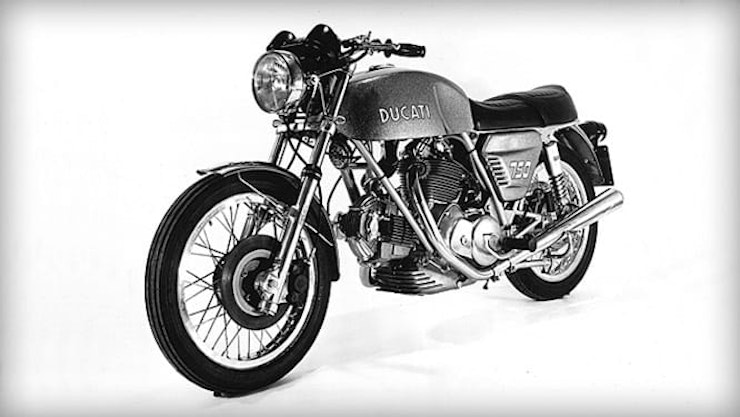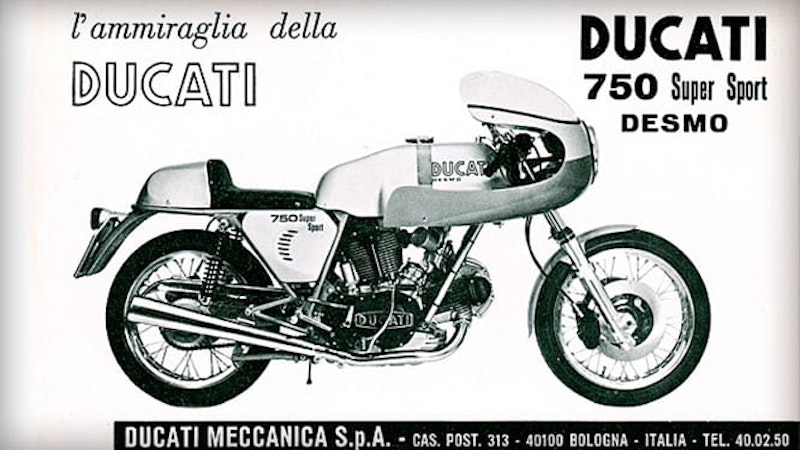Author: Jon Urry Posted: 04 Jul 2016
With the internet alive with leaked images of a brand new Ducati Supersport model, we thought it was time to reveal why this brand means so much to the boys from Bologna. And why the time is now right for it to reemerge…
The first of the breed
While Ducati’s race heritage ensured that the firm had a plethora of Sport models in its lineup ever since the very first 175 Sport in 1957 (although if a 175cc single could be called sporting is up for debate), what are regarded as the first the true Sport models arrived in the 1970s.
Designed by the legendary Fabio Taglioni, they were based around the fairly unsporty 750GT. This machine, which used the ‘round case’ air-cooled desmo V-twin motor, was Ducati’s first V-twin and was essentially two singles bolted together with a 90-degree spacing to create a 750cc motor. Launched in 1971, the GT was popular but it was only when Paul Smart won the Imola 200 in 1972 on a 750 V-twin that enough momentum was gathered to converted it into the 750 Sport.
Taglioni had always wanted to build a sporty V-twin (a prototype Sport was seen in 1971) and the Sport came with drop bars and even a fibreglass tank and single seat. It also came in a stunning shade of yellow, which certainly made it stand out. However now Taglioni’s dream had come to fruition he wanted more. Faced with tough competition from the Japanese, he designed the 1974 750 Super Sport, which was lighter and even sportier. The first Ducati Super Sport model had arrived and only 401 were ever built.
To this day the 750 Super Sport remains the stuff of legends and the road bike looked every inch the Imola racer. With a silver half-fairing, silver paint and a sea green frame, it was stunning to look at and certainly performed as well, topping 135mph in road tests. The 750 Super Sport remained in production until 1979, although by this time the 1975 900 Super Sport with its ‘square-case’ engine had rather taken the shine off its sales and later 750 Super Sport models weren’t nearly as sought after as the original bike. Despite the Super Sport (or by this time it was shortened to SS) tag living on in the late 1970s and early 1980s in the shape of the 900SS Darmah, it wasn’t until 1990s that it truly emerged again.
The return of the Super Sport
In 1985, the Cagiva group and its charismatic and visionary boss, Claudio Castiglioni, bought Ducati. A very clever business man with a keen eye for Ducati’s sporting heritage, Castiglioni first rejuvenated the 750 Sport name in 1988 using an air-cooled engine before a year later releasing a new Super Sport model – the 900SS. Interestingly, he called it Supersport not Super Sport, possibly to highlight the fact the bikes weren’t full-on superbikes. Where in the 1970s the Super Sport models were winning races, the 1990s were a very different time. Ducati had water-cooled its V-twin in the 1988 851 as well as adding a four-valve head and in comparison the air-cooled 900SS with its 2-valve sohc motor wasn’t that sporty or fast. So what was it? The 900SS was marketed as an all-round sportsbike that was cheap to buy and run while also looking elegant and handling as riders expected a Ducati would. And it was this clever targeting that ensured the SS name went on to become one of Ducati’s most popular and best-loved models.
The glory years
During the 1990s, Ducati’s sporting prowess was there for all to see. The firm was riding high in the World Superbike series and its 888 and later 916 range of models were the ultimate in Italian exotica. But there was a problem. Owning exotica comes at a financial cost and many Ducati fans simply couldn’t afford an 851, 888, 916 or even the more budget 748. It was these buyers that looked towards the SS models.
Sensing riders wanted to buy into Ducati’s sporting success, in 1991 Ducati expanded the SS range. The air-cooled engine lent itself to a variety of capacities and in 1991 Ducati launched the 350SS, 400SS (this was mainly for the Japanese and German markets) and the 750SS, all using the same basic platform as the 900SS. The range then grew even further in 1994 with the 600SS and diversified with half-faired models joining their fully-faired brethren. The SS bikes quickly formed a reputation for being reliable, easy to work on, practical, good looking but above all, still true to the Ducati sporting heritage. And that’s why riders loved them. But love can be fleeting…
The downfall
In 1996 Ducati was going through some serious financial issues that eventually saw it bought out by the American Texas Pacific Group (TPG). This buyout delivered both good and bad news to Ducati and the SS range. With TPG’s cash now in its coffers, Ducati began a massive model expansion drive that was headed up by its new chief of design, Pierre Terblanche. And the 900SS was on his list of bikes to be restyled…
In 1998 the all-new SS range emerged. Gone were the SS’s slab sides, replaced by swooping curves and an all-together more fluid style. Like so many of Terblanche’s designs, it was controversial but unlike the later 999, SS riders were more open to change. Owners of the SS bought the bike on its attitude more than its look and while the hugely popular Monster had replaced the SS as Ducati’s main seller, the SS models certainly held their own. However by the start of the 2000s they were in need of a bit more grunt.
With the Monster range proving the worth of the air-cooled engine, Ducati expanded its capacity to 1000cc and also gave it a new dual spark head to improve its efficiency and pass new emission laws. Sharing essentially the same platform as the Monster, the 900SS inherited this motor in 2003 to become the 1000SS. But in truth the writing was on the wall for the SS.
TPG’s main failure at the helm of Ducati was to create a confusing and far too varied model line-up, something the SS reflected. Riders didn’t want the choice of a 600SS, 750SS, 800SS or 1000SS in the same way they didn’t want a 600, 750, 800 or 1000 Monster, but TPG didn’t spot this and very quickly the funding taps were turned off in the R&D department as once again Ducati was on shaky financial ground. Unpopular models were weeded out prior to TPG’s sale of the company back into Italian ownership and the Supersport range was deemed a relic of the past. Why? In truth it was a combination of many factors. Ducati’s ST range were taking over the sport touring duties alongside the Multistradas while price was becoming less of a barrier for sportsbike fans who wanted the 998 or 999. The 1000SS was left in the wilderness (the 800SS died in 2005) and by 2006, the year after TPG sold Ducati, it was killed off. Or more precisely, put in ice.
The return
So why in 2017 does Ducati feel the time is right to relaunch the Supersport name? The world is a very different place now and there is certainly a demand for reasonably priced sportsbikes that aren’t too sporty. Considering the likes of a 1299 Panigale costs £17,025, the Yamaha YZF-R1 £14,999 and the Kawasaki ZX-10R 13,649 there is certainly an argument that a more budget sportsbike is needed, especially as the ‘entry level superbike’ 959 Panigale is £13,095. The rumours say the new Supersport will use the Hypermotard 939’s engine (and probably many of its chassis components), which will put it in the £10,000 bracket. If it also has a relaxed riding position combined with a sporty but not too over the top attitude it could well inspire a new generation of Ducati Supersport fans. Here’s hoping it hits the right mark in the same way it did back in the 1990s.

